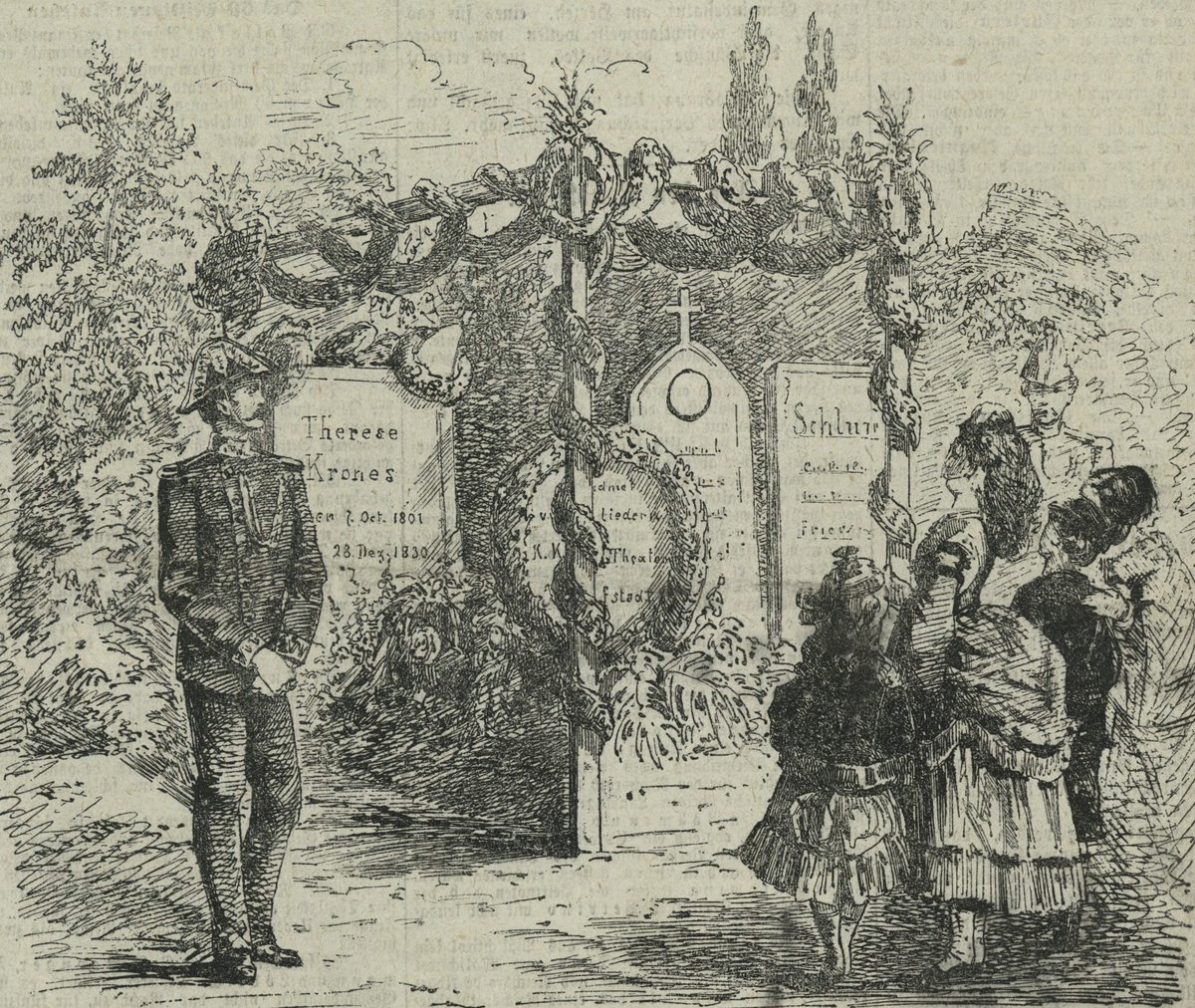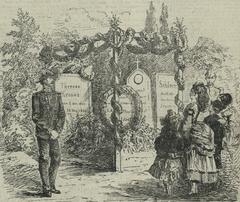
St. Marx Cemetery Vienna: Visiting Hours, Tickets, and Historical Significance
Date: 14/06/2025
Introduction
St. Marx Cemetery (Sankt Marxer Friedhof), located in Vienna’s Landstraße district, is a remarkable testament to the city’s layered history and cultural richness. Established in 1784 as part of Emperor Joseph II’s Enlightenment reforms, St. Marx reflects Vienna’s evolution in urban planning, public health, and social order (Wien.gv.at). Today, it is celebrated both as the final resting place of Wolfgang Amadeus Mozart and as a tranquil green space where Biedermeier-era monuments are entwined with nature, offering visitors a unique and contemplative experience.
This detailed guide provides all essential information for planning a visit to St. Marx Cemetery, including its origins, notable graves, visiting hours, ticketing, accessibility, and travel tips. Whether you are a music lover, a history enthusiast, or simply seeking a serene escape within Vienna, St. Marx offers a profound journey through the city’s artistic and cultural heritage.
Table of Contents
- Introduction
- Historical Overview (1784–1874)
- Architectural and Landscape Features
- Closure, Preservation, and Restoration
- Notable Burials and Memorials
- Visiting Information: Hours, Tickets, Accessibility
- Guided Tours, Events, and Photographic Opportunities
- Cultural and Artistic Significance
- Practical Visitor Tips
- Nearby Attractions
- Frequently Asked Questions (FAQ)
- References
Historical Overview (1784–1874)
St. Marx Cemetery was established during a period of major reform in Vienna’s burial practices. In 1784, Emperor Joseph II mandated the closure of inner-city cemeteries to address public health concerns and modernize urban planning, pushing new burial grounds outside the city walls (Wien.gv.at). St. Marx, named after a nearby hospital and church, was one of five new cemeteries constructed to serve the city’s growing population.
The cemetery’s design reflects Enlightenment principles: straight, rational paths and egalitarian placement of graves, with no separation by social class. Its layout symbolizes the era’s ideals of order, rationality, and equality (Vienna Unwrapped).
Architectural and Landscape Features
Spanning about 60,000 square meters, St. Marx Cemetery is enclosed by remnants of its original brick wall. The entrance gate, constructed in the late 18th century, stands as a simple, dignified portal. Tree-lined avenues, overgrown meadows, and a remarkable array of Biedermeier-era monuments create a landscape where art and nature blend harmoniously (Vienna Unwrapped; barbarawehr.at).
The gravestones showcase neoclassical motifs—urns, weeping willows, and broken columns—emblematic of mourning and the fleeting nature of life. The cemetery’s semi-wild vegetation, including wild roses and ancient trees, contributes to its romantic, melancholic atmosphere.
Closure, Preservation, and Restoration
St. Marx Cemetery ceased new burials in 1874 with the opening of Vienna’s Zentralfriedhof (Central Cemetery). By this time, more than 30,000 people had been interred at St. Marx (Wien Museum). After closure, the site suffered periods of neglect. However, public advocacy preserved it from redevelopment, and in 1937, it was declared a protected monument (Bundesdenkmalamt).
In the 20th and 21st centuries, significant restoration efforts have stabilized monuments and cleared overgrowth while maintaining the site’s distinctive character. Today, St. Marx is recognized for both its historical value and its ecological significance, serving as a habitat for rare flora and fauna (Wien.gv.at).
Notable Burials and Memorials
Wolfgang Amadeus Mozart
St. Marx Cemetery is internationally renowned as the burial site of Wolfgang Amadeus Mozart, who died in 1791. Due to burial customs of the time, Mozart was interred in a “common grave,” not a pauper’s grave, and the precise location remains unknown (Mozart Memorial; barbarawehr.at). A memorial stone and statue now mark the field believed to be his resting place, making it a site of pilgrimage for music lovers worldwide (Visiting Vienna).
Other Notable Graves
- Anna Gottlieb: Soprano who originated the role of Pamina in Mozart’s “The Magic Flute” (barbarawehr.at).
- Josef Madersperger: Inventor of the sewing machine (Guides in Vienna).
- Basilio Calafati: 19th-century showman and Prater carousel owner (Guides in Vienna).
- Moritz Michael Daffinger: Miniaturist and portraitist (Guides in Vienna).
- Peter Fendi: Painter and engraver of the Biedermeier period (Guides in Vienna).
Some prominent graves, including the original Mozart monument and the graves of Josef Kornhäusel, Ida Pfeiffer, and Josef Strauss, have been relocated to Zentralfriedhof (Wien.gv.at).
Visiting Information: Hours, Tickets, and Accessibility
-
Visiting Hours:
- April to September: 6:30 am – 8:00 pm
- October to March: 6:30 am – 6:30 pm
- Check official sources for seasonal updates.
-
Admission:
- Free entry for all visitors.
-
Guided Tours:
- Available seasonally via Vienna’s cultural institutions and tour operators. Tours focus on history, notable burials, and artistic features. Booking in advance is recommended (Veronika’s Adventure).
-
Accessibility:
- Main paths are relatively flat but some areas are uneven and overgrown; full wheelchair access is limited. Visitors with mobility needs should plan ahead or join accessible tours (Veronika’s Adventure).
-
Getting There:
- Tram: Take lines 18 or 71 to “St. Marx”, then follow signs to the cemetery (Visiting Vienna).
- Bus: Line 74A to Hoffmannsthalgasse.
- The entrance is at Leberstraße 6-8, 1030 Vienna.
Guided Tours, Events, and Photographic Opportunities
St. Marx Cemetery offers guided tours focusing on its history, funerary art, and notable burials, especially Mozart. Seasonal events, such as classical concerts and commemorations, are occasionally held on-site. The cemetery is a haven for photographers—early morning or late afternoon provide the best light for capturing its atmospheric paths and intricate gravestones.
Cultural and Artistic Significance
St. Marx stands as a rare surviving Biedermeier-era cemetery. Its monuments, with neoclassical symbolism and poetic inscriptions, are masterworks of funerary art. The interplay of weathered stones and natural overgrowth creates a romantic, contemplative atmosphere that has inspired writers, artists, and photographers (Atlas Obscura; barbarawehr.at).
The cemetery’s association with Mozart and other notable figures cements its role as a cultural pilgrimage site. Its egalitarian layout and tranquil setting offer a poignant alternative to Vienna’s grand imperial memorials.
Practical Visitor Tips
- Photography: Permitted throughout the cemetery. Use discretion and be respectful of the site (Veronika’s Adventure).
- Food/Drink: Not permitted inside to maintain the cemetery’s respectful atmosphere.
- Facilities: Restrooms available near the entrance.
- Best Times to Visit: Spring and autumn for blooming lilacs and pleasant weather; early morning or late afternoon for fewer visitors.
- Etiquette: Stay on marked paths, keep noise low, and supervise children.
Nearby Attractions
- Zentralfriedhof (Central Cemetery): Burial site of Beethoven, Brahms, Schubert, and Strauss (Visiting Vienna).
- Marx Halle: Event venue for festivals and concerts.
- Gasometer: Redeveloped historical gas tanks with shops and entertainment.
- Belvedere Palace: Baroque landmark with art collections.
Frequently Asked Questions (FAQ)
Q: What are the current opening hours?
A: April–September: 6:30 am–8:00 pm; October–March: 6:30 am–6:30 pm.
Q: Is there an entrance fee?
A: No, admission is free.
Q: Are guided tours available?
A: Yes, tours are available seasonally and are recommended for deeper insight.
Q: How do I reach the cemetery by public transport?
A: Tram lines 18 or 71 to “St. Marx” stop, or bus 74A to Hoffmannsthalgasse.
Q: Is the cemetery accessible for wheelchair users?
A: Full wheelchair access is limited due to uneven terrain; inquire in advance for assistance or accessible tours.
Q: Can I take photographs?
A: Yes, photography is allowed; please be respectful.
Q: Are food and drinks allowed inside?
A: No, to preserve the atmosphere, food and drinks are not permitted.
References and Further Reading
- St. Marx Cemetery in Vienna: History, Visiting Information, and Cultural Significance (Wien.gv.at)
- The Legacy and Visitor Guide to St. Marx Cemetery (barbarawehr.at)
- Visiting St. Marx Cemetery in Vienna: Hours, Tickets, and Notable Graves (Visiting Vienna)
- St. Marx Cemetery Visiting Hours, Tickets, and Guide (Veronika’s Adventure)
- Mozart Memorial, Vienna Tourism
- Vienna Unwrapped, St. Marx Cemetery Overview
- Wien Museum, St. Marx Cemetery
- Atlas Obscura, St. Marx Cemetery
- Guides in Vienna, St. Marx Cemetery
Conclusion
St. Marx Cemetery is a serene and richly atmospheric destination that offers a unique window into Vienna’s history, art, and music. From the enigmatic legacy of Mozart to the evocative Biedermeier monuments, the site invites visitors to reflect on the city’s cultural past amidst tranquil natural surroundings. Free admission, extended visiting hours, and guided tours make it accessible and enriching for all. Pair your visit with nearby attractions for a full Viennese cultural itinerary.
Plan your visit today to experience this living dialogue between past and present, and discover why St. Marx Cemetery remains one of Vienna’s most treasured historical landmarks.






















































































































































